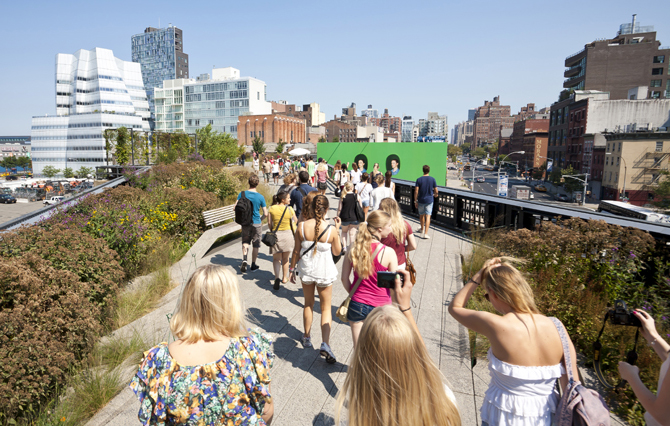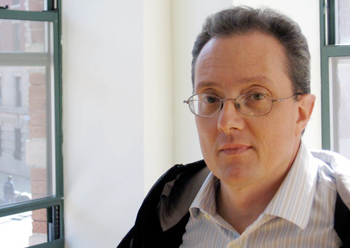Throughout the 1980s and early 1990s, a long stretch of abandoned elevated railway sat decaying on the West Side of Manhattan. Once a vital part of an industrialized Hudson River waterfront, the railway was eventually slated for demolition.
Two area residents, however, had a different idea. Although they were just ordinary citizens with no expertise in development or land use, the two saw something that the developers and planners didn’t see. Where others saw only a rusting eyesore, they envisioned a “park in the sky,” an elevated green space weaving between buildings and above traffic.
Over the course of 10 years, from 1999 to 2009, the two brought together architects, business leaders and philanthropists, persuaded public officials, and overcame a host of skeptics to bring their ideas to fruition. The result was the High Line, a beautiful elevated park that stretches over 1.5 miles.
Today, walking along the High Line, you can hear children running and playing and feel the tracks beneath your feet. You can taste food and coffee from a kiosk, see the city and the Hudson in whole new ways, and smell the native grasses and flowers planted along the walkway. Engaging all the senses, the High Line is now an integral part of New York’s urban fabric, designed with simplicity and attention to detail, and deeply connected to the city and its history.
The High Line, though, is not just an object lesson in urban planning. To us, it also holds valuable lessons for what it means to be in ministry in the city. Ministry in the city that works well is ministry that flourishes and is sustainable, working with the city, its history, people and potential. It sees new possibilities for the kingdom in the materials right in front of us, within the networks and complexities of everyday life.
Even if we don’t live in a city, we all live in an urban age. More than half the world’s population now lives in cities, and over the next three decades, demographers report, that number will climb to at least two-thirds. Whether we live in the Mississippi Delta or Chicago or Mumbai, cities influence all aspects of our lives, from energy to food, from economics to the environment.
Not surprisingly, scholars say planetary urbanization is a present reality with important implications for the church. Consider just these two: the average Christian throughout the world lives in a city, and the church, whether it uses this language or not, is increasingly an urban church, with all the challenges and opportunities that urban life presents.
Yet typically, when Christians think about “urban ministry” -- what we at City Seminary of New York prefer to call “ministry in the city” -- we picture experts or religious specialists whose job it is to do ministry in the city. We might think about how to start or renew congregations, reach different groups, meet a deep need or speak out about some important issue. And we likely think about a metropolis such as New York or Chicago -- and rarely, if ever, the city in which we live.
But, alone, this approach is incomplete. It can keep ministry fixed in isolated and preconceived roles and make us more passive in our own communities and everyday lives. It can keep us focused on programs and cause us to miss the importance of presence.
At City Seminary of New York, we have found that ministry in the city is most generative and sustainable when it begins with the senses, with our everyday experiences as embodied beings with diverse callings and vocations. Our approach to ministry begins with how we see, hear, taste, smell and touch the city.
It begins with relationships, with being attentive to the world around us, with taking time in a fast-paced world to experience and understand the city. Rather than being limited to a project or plan, ministry is foremost about our everyday life in the city.
Focusing on the senses brings us in touch with the richness of Christian thought and tradition in ways often neglected in the West. At the heart of this tradition is the incarnation, an affirmation of God’s life given for our world.
The writer of 1 John begins: “We declare to you what was from the beginning, what we have heard, what we have seen with our eyes, what we have looked at and touched with our hands, concerning the word of life” (NRSV). To think of the Eucharist or baptism, or to consider the history of reading Scripture in the ancient church, is to be very much aware of different senses at work in the living Word.
The senses form the basis for ministry, because knowledge and actions are related to our bodies; we learn the practice of ministry by engaging in it. Indeed, we are sensate beings, and the city tells us its story through the senses. As others have noted, we can think of the city itself as a body, a living organism with a multitude of unique, interdependent parts. Through our living bodies we encounter the living city.
One of the key ways we bring all the senses together at City Seminary is through an activity we call “pray and break bread.” In this ongoing series of events, which has been part of the school from the beginning, we literally pray and break bread in neighborhoods throughout New York. In the process, we introduce students and other participants to an understanding of theological education in the city that is grounded in sensory, bodily life.
Several times each year, faculty, students, family and friends gather in each of the five boroughs of New York to walk, pray and eat together. A typical “pray and break bread” event begins with everyone meeting on a Saturday morning in Queens or Harlem or some other location to learn about the history and contemporary dynamics of a particular community. After reading Scripture, we walk and pray in small groups, regathering at the end to reflect on our experiences and to share a meal at a local restaurant.
This year, in keeping with the seminary’s current theme -- “Create for the peace of the city” -- we have expanded our “pray and break bread” events to explore several neighborhoods that are also sites of art and culture -- areas such as Long Island City in Queens, Stapleton on Staten Island, the Grand Concourse in the Bronx, Chinatown in Manhattan and Greenpoint in Brooklyn. Along the way, we witness and celebrate creation and the restoration of goodness all over our city. We partner with God and neighbor in sensing that more is going on than we see with our eyes alone.
Walking together, praying in styles from silent to Pentecostal, we see church life intertwined with the creative and economic life of the city. We listen to people and to Scripture. We touch the surfaces of the city. We smell the air, taste the food and build community together. In all these experiences, we learn more of the city’s complexity and diversity. We see in new ways that God is already present.
“Pray and break bread” is also a response to the prophetic call of Jeremiah: “Pray to the Lord for the city, for if it experiences peace, you too will experience peace” (Jeremiah 29:7). It nourishes a way of being in the city, creating a space for us to see, participate in and imagine anew what God is doing and inviting us to do in the city. Over the years, as we take part in more and more “pray and break bread” events, we develop a set of habits that can also become a way of life -- a prayerful way of knowing the city rather than just knowing about it.
We also become formed in patterns of attentiveness and discernment vital to the faithful practice of ministry. The senses, and their cultivation, become the foundation and the building blocks for our gifts and callings in the church and the city. They help us to learn about ourselves, and to become aware of our own development in communion with God.
Listening, for example, is foundational to all areas of work and life, and essential for pastoral ministry. Truly listening to people’s stories, struggles and cries -- especially cries that often go unheard -- is critical for ministry. And being able to listen -- not just speak -- is crucial -- for transmitting the gospel to young people.
Generative and faithful ministry is for the whole people of God in the whole city. It occurs where we live, work, worship, play and raise our families -- whatever city we live in, whether in North America, Africa, Asia or Latin America. It occurs whether we are longtime residents or new immigrants, young or old, full-time pastors or bi- or multivocational church workers, stay-at-home parents or students, finance leaders or building superintendents, health care workers or artists.
As Michael Kimmelman, the New York Times architecture critic, has noted, walking along the High Line allows us to see the city in a new way.
As you walk around your city, use all your senses to perceive it afresh. Then, as each of us walks, observes, and experiences in our own particular contexts, we can together cultivate the practice of innovative and adaptive ministry in the city, for the flourishing of our urban world.
Editor’s note: This reflection was written as part of the Practices of Ministry in the City Project at City Seminary of New York. Funded with a grant from Lilly Endowment Inc., the project is gathering stories, strategies, emerging questions, case studies and theological reflections from local, national and global urban ministry practitioners and theologians in order to better understand the practice of ministry in our present urban world.











